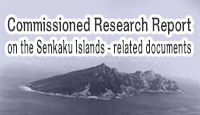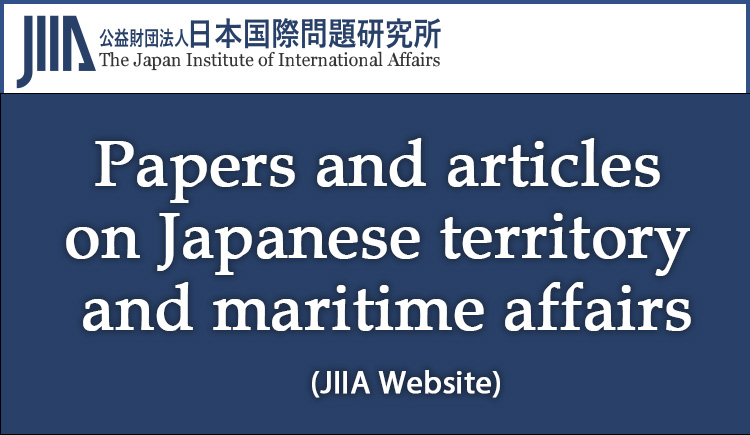The documents and materials published on this website were collected, researched, and prepared with advice from experts, as a part of a Government-commissioned project. The contents of this website do not reflect the views of the Government. Links to external sites (domains other than https://www.cas.go.jp) are not under the management of this site. For linked websites, please check with the organization/group that manages the website for the link in question.
Analysis of claims by other countries
Column
Where is “Diaoyu Tai,”
which China asserts as part of Taiwan, located?
Satoshi Hirano (Professor, The University of Tokyo Faculty of Law)
*Adobe Acrobat Reader DC, provided by Adobe, is needed to view the PDF files. If you do not have the software, please download it from the linked site. Adobe Acrobat Reader DC
1. China’s claim that the Senkaku Islands are part of Taiwan
The government of the People’s Republic of China claims that “Diaoyu Dao [Note: Diaoyu Dao is the Chinese term for the Senkaku Islands] and its affiliated islands are an inseparable part of the Chinese territory.” It asserts that “the Qing court… clearly placed the islands under the jurisdiction of the local government of Taiwan.” (The State Council Information Office of the People's Republic of China, “Diaoyu Dao, an Inherent Territory of China,” September 25, 2012.)
In fact, the Senkaku Islands did not belong to any country until 1895. The Japanese government carefully confirmed this fact before it incorporated them into Japan’s territory. Then on what basis does China claim that the Senkaku Islands are “an inseparable part of the Chinese territory?”
China cites historical books, A Tour of Duty in the Taiwan Strait (Tai Hai Shi Cha Lu) [台海使槎录] and Recompiled General Annals of Fujian (Chong Zuan Fu Jian Tong Zhi) [重纂福建通志], compiled by Qing bureaucrats, as documents which show that the Qing court “clearly placed the islands under the jurisdiction of the local government of Taiwan” in the pre-modern era before the 19th century, and claims that the geographic name of “Diaoyu Tai” in these books refers to “Diaoyu Dao,” located far northeast of Taiwan (“Diaoyu Dao, an Inherent Territory of China,” Chapter I.2.)
It is true that these writings mention the geographic name of “Diaoyu Tai,” which China claims to be one of the Chinese names for Uotsuri Island (in the Senkaku Islands), and it may be argued that Qing bureaucrats at least knew of this name when the books were written. However, as explained further below, it is impossible to argue that the Qing officials had control of “Diaoyu Tai.” Furthermore, there is no doubt that “Diaoyu Tai” in these writings does not refer to the Senkaku Islands, but to a rocky hill along the coast of Taiwan Island.
This essay will examine China’s assertions, looking one by one at the specific contents and contexts quoted by China in the historical books, A Tour of Duty in the Taiwan Strait and Recompiled General Annals of Fujian.
2. Qing’s strategy for the defense of Taiwan as described in A Tour of Duty in the Taiwan Strait
Let us start with A Tour of Duty in the Taiwan Strait. The present subject is based on the first issue of Taiwanese documents which was published in 1957 compiled by Economic Research Office of the Bank of Taiwan. In this section, first, I will explain the background behind the creation of this book, and subsequently, the part which mentions “Diaoyu Tai,” starting from the related passages prior to it. By following the contextual flow, we can naturally identify the location that the geographic name of “Diaoyu Tai” points at.
(1)A Tour of Duty in the Taiwan Strai
― A guide to governing Taiwan written by a Qing official in the 18th century
A Tour of Duty in the Taiwan Strait was written by Huang Shujing, a Qing bureaucrat, sometime later than 1722.
In 1683, Qing overthrew the Zheng clan, who ruled western Taiwan, and then steadily solidified control over Taiwan, where the armed confrontations over land, called xie dou,
continuously happened between the Austronesian natives, the Fulao from southern Fujian Province (Minnan) and the Hakka from eastern Guangdong Province.
The land disputes in Taiwan were caused by overpopulation in the underdeveloped island due to the inflow of people who had difficulties living in Fujian and Guandong and had secretly crossed the sea in search of a new place to live.
It was impossible to establish a firm rule over Taiwan without first controlling and restricting the people who secretly traveled to Taiwan.
In the meantime, major military challenges lay in Taiwan at the time. Taiwan is so distant from Beijing, the capital of the Qing Dynasty where the nomadic Manchus and Mongols held power, that the armed forces deployed there were of lesser quality. At the same time, the bitter memories of the ravages of Japanese pirates in the time of the Ming Dynasty had been shared among the bureaucrats under the imperial examination system and people in the coastal areas at that time, and there was a need to be prepared for the next possible assaults by Japanese pirates (in fact, since the beginning of the Tokugawa Shogunate, the activities of the Japanese pirates had already ceased, and Japan had limited its relationship with Qing to the comings and goings in Nagasaki. Therefore, there was a recognition, as was shown by Lan Dingyuan, an official who was involved in the rule of Fujian in the first half of the 18th century, that it would not be a trouble as far as the Japanese did not come at all).
Under these circumstances, the Zhu Yigui rebellion occurred mainly in today's Kaohsiung and Tainan in 1721, which threatened Qing’s rule over Taiwan. This was an armed uprising by people who were angry at the increasing oppression by Qing local officials on the impoverished under the leadership of Zhu Yigui, who claimed to be a descendant of the imperial family of Ming, in order to overthrow Qing and restore Ming. Qing sent in reinforcements from Fujian Province via the Penghu Islands and managed to suppress this rebellion. However, Qing was confronted with an extremely challenging task of how to rule this chaotic island far from the mainland.
Therefore, Qing sent Huang Shujing, a high-ranking official who had passed the Jinshi exam in the imperial examination system, to inspect Taiwan shortly after the turmoil. These records were compiled into A Tour of Duty in the Taiwan Strait, which includes citations from Chinese geographic and military materials referring to Taiwan after the Ming period as reference. Huang Shujing explains in detail the management of ports as a cornerstone of Taiwan’s defense, and detailed descriptions is found in a part of Vol. 2 Chikan Notes: Military Preparations (Chi Kan Bi Tan Wu Bei) [赤嵌笔谈 武备], in which “Diaoyu Tai” appears.
This part of the book first cites The Essentials of Historical Geography (Dushi Fangyu Jiyao) [读史方舆纪要](→Material 1)about the management of the Penghu Islands during the Ming period. It points out that, to cope with Japanese and other pirates, and the possibility of Toyotomi Hideyoshi targeting Taiwan following the dispatch of his forces to Korea, Penghu Island with its calm bay mouth and Taiwan’s Beigang (today's Beigang Township, Yunlin County), located southeast of Penghu Island, should be defended, which had a critical impact on the defense of the coastal areas of Fujian Province, but records that Taiwan was seized by Hongmao (the Netherlands) during the Tianqi era in the first half of the 17th century in the late Ming Dynasty.
Subsequently, the description in the book is followed by a quotation from Collection of Administrative Documents from Dongning (Dong Ning Zheng Shi Ji) [东宁政事集](→Material 2) written by Ji Qiguang, a bureaucrat at the onset of Qing’s rule over Taiwan. Starting from around today’s Gangshan District, Kaohsiung City in southern Taiwan, it describes as the “North Route” the names of places appearing northwise (clockwise) on the west coast and as the “South Route” those appearing southwise (counter-clockwise) on the west coast. A description about the North Route goes, “As for Jilong and Danshui, they are the northernmost islands in Taiwan, jutting out of the sea and connecting fanshe (番社, indigenous villages).” Jilong [鶏籠] and Danshui [澹水] are today's Keelung City and Tamsui District, New Taipei City, respectively. This represents that since the late 17th century, there had been a recognition among officials in charge of Taiwan that this area lay in the northernmost part of Taiwan. This book goes on to suggest that the various ports on the North Route be tied with the ports of Fujian Province facing across the Taiwan Strait to encourage Fujian merchants to trade with Taiwanese ports on the other side of the Strait, thereby to strengthen commercial and military ties with Taiwan.
Next, the book, goes on to cite On Rule of Taiwan (Li Tai Mo Yi) [理台末议] written in 1728 by Xia Zhifang after inspecting Taiwan, describes the deployment of defense forces in Taiwan(→Material 3). Regarding the defense on the ground, it advocates the implementation of the farmer-soldier system, in which farmers are to engage in agricultural work on a daily basis and take up arms in emergencies, from the viewpoint of costsaving in consideration of the vastness of the land. In terms of maritime defense, it follows the well-established naval defense theory in the period of the Ming dynasty, stating “the navy avoids fighting in the open sea, and heads for ports to take up arms; therefore, the ports shall be battlefields. Accordingly, a good understanding of ports is essential for good command of the navy. The port is to the navy what the castle is to the army.”
The viewpoints expressed in the above-mentioned quotations indicate that Huang Shujing, author of A Tour of Duty in the Taiwan Strait, intended to raise awareness of the necessity to have a grasp of ports on the Penghu and Taiwan Islands as commercial bases and battlegrounds, and to build up the military forces there.
Moreover, Huang Shujing enumerated the following: past records of patrols around Penghu Island; criticism against the plan shortly after Qing’s acquisition of Taiwan to concentrate the deployment of the arms in Penghu by shifting those in Taiwan, the deployment of naval forces in Anping (Tainan) and the instruction manual of their annual patroling; increasing use of Takau Port (today's Kaohsiung) by civilian vessels; the expansion of the rules over the northwestern coastal areas of Taiwan during the Kangxi era; and a need to improve the quality of the military personnel deployed in Taiwan(→Material 4).
Following these summaries of the background, the current state, challenges and others from the viewpoint of the strategy on Taiwan for the mainland Qing, a description of “Diaoyu Tai” appears in the section of the book.
Material 1
A Tour of Duty in the Taiwan Strait, p. 24-25
In the fifth year of the Hongwu era (1395) of the Ming Dynasty, Tang Xinguo governed the sea. He suggested moving the islanders inland because he found it difficult to judge whether they were loyal or rebellious.
In the 21st year (1388), all the islanders were relocated, and then the police department (xunjiansi, 巡检司) was abolished, reducing Penghu to a wasteland.
However, rogues with ambition continued to lurk on the island afterwards. Japanese pirates came and went, passing through this area to stop at the port for water. After the Jiajing and Longqing eras,
Zeng Yiben and other pirates recruited bandits here many times. In the 20th year of the Wanli era (1592),
Japanese pirates invaded Korea. The sentries said that those pirates were going to invade Jilong and Danshui (澹水) next,
suggesting that troops be stationed there. In the 25th year of the Wanli era (1597), guerrilla forces were deployed additionally.
In the 45th year of the Wanli era (1617), additional assault and guerrilla forces were deployed again after Japanese pirates invaded Longmen Port. About 200 li around Penghu,
(the geology was salty and alkaline, and the water was salty and bitter.
Daily scorching heat and frequent winds made it difficult to grow crops.)… Located in the center was Nianggong Islet.
Twenty li from Xi Islet was Chapan Islet, and ten li further on was Nianggong Islet.
The sea here was calm…… Its state resembled that of the surface of a lake, hence the name Penghu. It was large and wide enough for ships to stop(omission)
……In the 37th year of the Wanli era (1609), a hongmao (Dutch) ship reached Penghu, stopping there for a long time before leaving.
In the second year of the Tianqi era (1622), Gao Wenlu, taking advantage of the garrison being isolated and weak, suddenly mobilized a dozen ships and occupied Penghu Island,
using the mountains as castle walls and the sea as a moat. He sailed on through the wind and waves, surging with great momentum into Zhangzhou and Quanzhou and wreaking havoc there. At the time,
Yu Zigao, the regional commander (zongbing), moved the hongmao to Beigang and recovered ,namely, Penghu. He also resolved to lay the foundations of castle walls in Mount Wen’ao……
sent troops to be stationed here to hold Nianggong in control. However, those who made the resolution also said that Penghu was the gateway to Zhangzhou and Quanzhou,
that Beigang and Penghu were mutually dependent, and that if Beigang fell, it would endanger not only Penghu, but also Zhangzhou and Quanzhou. Beigang, also known as Taiwan,
is located to the southeast of Penghu; after the Tianqi era, it was occupied by the hongmao.
Material 2
A Tour of Duty in the Taiwan Strait, p. 26
The South Route goes southward from Dagangshan down to Xiadanshui (Wandan Township, Pingtung County) and Langjiaoshe, and the North Route goes from Mugangshan up to Shangdanshui and Jilongcheng.
Between them, Fongshan, Mt. Kuilei (the region of Rukai Tribe), Mt. Zhuluo (Chiayi), and Mt. Banxian (Changhua) are all critical points for defending Yefan and places that the army must defend.
Xiadansui, Sulphur River (硫磺溪), Daxiantou, and Luzai Port are all on the main routes into the sea, which the navy must defend.
As for Jilong and Danshui, they are the northernmost islands in Taiwan, jutting out of the sea and connecting to the fanshe (番社, indigenous villages).
Houlong Port faces Nanri, which is at the mouth of Xinghua Port. Located 120 li to the north of Houlong is Zhuqian She (竹堑社) (Hsinchu County) facing Haitan Township.
Located 150 li to the north of Zhuqian is Nankan She (南嵌社) facing Guanbeng, which is a port of Min’an, Fuzhou.
It is 70 li from Nankan to Shangdanshui facing Beijiao; it is 300 li from Danshui to Jilong facing Shacheng and Fenghuomen.
All are along the boundary of Zhejiang Province. Beyond the ocean is the way in and out for the hongmao.
Because of the long distance from commanderies, waterways extended in all directions, and all it takes to get there directly is a sailing ship.
The descendants of the Zheng clan deployed heavy troops in Jilong, and although they claimed it was in preparation for the hongmao, whom they had defended themselves against at a distance,
they were indeed afraid that we would divide forces and assault their rear-guard from Fuxing.
It only takes approximately 14 to 16 hours from Jilong to Min’an by sea, and if the ports of Min’an and Xinghua allowed the comings and goings of merchants for business,
that would not only be a good source of finance, but in case of an unexpected warning, the forces in Xiamen and Penghu would also be able to act as the vanguard,
while the ships in Fuzhou, Quanzhou, and Xinghua would be able to provide logistics support, coordination between the front and the back, and emergency responses.
Material 3
A Tour of Duty in the Taiwan Strait, p. 27-28
The strength of Taiwan’s ground and naval forces exceeds 10,000 and military expenses are extremely heavy. That is, those in Penghu and Anping account for half of it.
The navy’s defense missions are too critical to allow any more reductions in personnel, and Taiwan’s strength accounts for half of it. The army’s defense area is vast,
and there is no choice but to resolve to reinforce ground forces. However, there is still a way to save money by the most convenient way which personnel engaged in logistics must pay attention to.
The official manors (guanzhuang, 官莊) already existent in Taiwan could be used as tuntian, and the ploughmen could serve as soldiers under the tuntian system.
However, it would be necessary to provide training and clearly stipulate rules to be followed. Otherwise, it would be necessary to follow the ancient system of “70% for ploughing,
30% for military preparations” (Geng Qi Diao San, 耕七調三) or set up fortresses to defend under the concept of “soldiers work as farmers in peace time and act as fighters in war time” (Yu Bing Yu Nong, 寓兵於農),
so that the soldiers would not only be freed from traveling far and wide, and the annual military expenses of the state would be saved……
While the army values the power of horses, the navy values the power of ships. When faced with enemy forces, it is essential to compete for an upwind position. Without agile mobility, it is impossible to occupy an upwind position.
If there is not enough weight to hold the ships, they may fall back downwind. Though this relies on manual operation, it totally depends on how good the warships are……
It is necessary to have good materials with a good balance of light and heavy ones, just like the whole-body muscles and bones in good coordination with each other, in order to achieve good mobility……
Therefore, the navy must place a great focus on shipbuilding……
Naval ships anchored in ports is analogous to ground forces camped on land. By and large the navy is not capable of fighting in the open sea, but crossing swards at ports; therefore, ports are battlefields……
Accordingly, the navy must have a good understanding of anchoring in ports, which is part of what makes sense. Naval forces attacking a port is analogous to ground forces attacking a castle.
Material 4
A Tour of Duty in the Taiwan Strait, p. 30-32
In the Xinchou year of the Kangxi era (1721), the Ministry of War reported, “Penghu is at the throat of Taiwan, located in a critical position.
The regional commander (总兵, zongbing) of Taiwan should be moved to Penghu, and the regional vice commander (副将, fujiang) of Taiwan should be stationed on land.
Huang Ying, the regional commander of Jinmen, reported, “Penghu is the gateway to Taiwan. Now, there is no better strategy than the regional commander of Taiwan being transferred to Penghu and the regional vice commander being stationed in Taiwan in coordination with the navy to examine the situation from a distance and to consult to do their best.”
I once read about the geographical features there. Although Penghu is said to be composed of 36 islands and is located halfway between Taiwan and Xiamen,
it is only a minuscule piece of land dotted with scattered islands. Except for some traces of human activities in Magong and Bazhao, all the other islands are desolate.
It can be defended just by deploying the regional vice commander. However, Taiwan stretches more than 2,000 li from north to south, with no less than a million villages, fanshe and households.
Mountains and deep forests are the easiest places for bandits to hide. No one can suppress them except for the regional commander. Moreover, each of the regional vice commanders and assistant regional commanders (canjiang, 参将) of the Anping navy and the South and North Routes are on a par with the regional vice commander of Taiwan.
Therefore, once something happens, all of them will have their own opinions, and no one can deploy them except the regional commander.
If the regional commander is stationed in Penghu, he would be separated from Taiwan.
Furthermore, while the ships coming and going between the two places are waiting for the wind, it would be impossible for him to rush to Taiwan even if the ground and naval forces in Taiwan are faced with an emergency.
While Penghu is the gateway to Taiwan, Taiwan is indeed the heart of Penghu, the importance of its situation exceeds that of Penghu’s, putting the critical points in each coastal province at stake.
Therefore, please keep the regional commander stationed in Taiwan.
…… The port of Takau in Fongshan is about six hours by sea from Lu’ermen (in west Tainan). When the north wind is strong,
the port of Lu’ermen is impossible for ships to enter due to the narrowness of its routes, while the port of Takau provides easy straight access;
therefore, there are many people landing there. The navy deployed two patrol ships in total to lead the defense.
Xiadanshui, far away from counties and towns, is prone to bandits; therefore, it is necessary for a company commander (qianzong, 千總) to lead the defense there.
These two are critical areas to defend on the South Route.
During the time of the descendants of the Zheng clan in Taiwan, the comings and goings of people were limited up to Banxian (Changhua).
There have been no traces of human activities in Danshui and other places since they were incorporated into our territory.
Therefore, only one centurion (baizong, 白总) was deployed in Dadu to lead the defense on the North Route; the two fanshes of Shalu and Niuma (Qingshui) were outside our territory.
After the pirate Zheng Jinxin escaped, the imperial court issued a notification to the effect thats the bandit who collaborated with Zheng Jinxin confessed that Zheng Jinxin should be hiding somewhere in Jinshan,
Huaniao, or Yushan (魚山) in Taizhou along the border of Jiangsu and Zhejiang, or in Danshui in Taiwan, Fujian, etc.
At that time, the regional commander Cui Xiangguo assigned a company commander to lead the defense of Danshui.
Since then, this has become the norm. Farm owners engaged in land reclamation, with a gradually increasing number of people coming and going.
Senkaku Islands
Research and Commentary Site
- I Comprehensive issues
- II Commentary on themes by historical period
- III Analysis of claims by other countries





